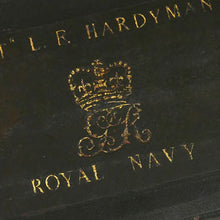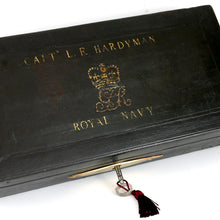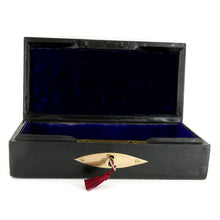Royal Navy - A Post Captain’s Despatch Box, 1800
Adding product to your cart
Length: 25.5cm (9.9in)
Black leather over wood with gilt brass fittings, the top tooled with the 'GR' cypher and inscribed 'Capt'n L.F. Hardyman - Royal Navy’ in gilt, with brass loop handle to one end; velvet lined interior and brass lock stamped 'E. Gascoigne’ (fl.1783-1795). Complete with key.
Captain (later Rear-Admiral) Lucius Ferdinand Hardyman, R.N., (1771–1834) entered the Navy at the age of ten. He received his baptism of fire at the Battle of the Saintes in H.M.S. Repulse (64-guns) on 9-12 April 1782, when Admiral Rodney defeated a French fleet under the Comte de Grasse, forcing the French and Spanish to abandon a planned invasion of Jamaica. He was promoted Lieutenant in 1795, and appointed to the fifth-rate 44-gun H.M.S. Sibylle under the command of Captain Edward Cooke, R.N. on the East Indies station.
Read more
In 1799 Hardyman was First-Lieutenant of Sibylle. when she was sent from Madras to hunt down the French commerce raider Forte. The French ship was engaged off the mouth of Hooghly River on the night of 28 February / l March 1799, and her captain killed by an early broadside. Forte’s crew continued to resist for more than two hours, only surrendering when their ship had been reduced to a battered wreck and more than a third of the crew killed or wounded. British losses by contrast were light, although Cooke was mortally wounded during the height of the action, leaving Hardyman to take command of Sybille and successfully conclude the battle with Forte, which was duly taken. Hardyman was afterwards promoted to Post-Captain by Vice-Admiral Rainier and given command of Forte which was commissioned into the Royal Navy. Hardyman was further rewarded by East India Company with and the insurance companies of Calcutta and Madras with three swords of honour.
In early 1801, H.M.S. Forte struck on an unknown rock as she was going into the harbour of Jeddah, and became a total wreck. Hardyman was acquitted of all blame, but the master of the flagship, who was piloting her, was sentenced to lose twelve months' seniority. In 1803 Hardyman commissioned the Unicorn frigate, which he commanded in 1805 on the West India station; in 1807 on the expedition against Monte Video under Sir Charles Stirling; and, in 1809, in the Bay of Biscay under Lord Gambier at the destruction of the French ships in Basque Roads. He was afterwards transferred to the frigate H.M.S. Armide frigate, which he commanded on the coast of France the final defeat of Napoleon. In 1815 he was made a Companion of the Bath. He commanded H.M.S. Ocean from 1823 to 1825 as Flag-Captain to Lord Amelius Beauclerk; became a Rear-Admiral on 22 July 1830, and died in London on 17 April 1834. He married the daughter of a director of the East India Company by whom he had one son, Lucius Heywood Hardyman, a Lieutenant 5th Bengal Cavalry, who was killed in the retreat from Cabul in January 1842.










